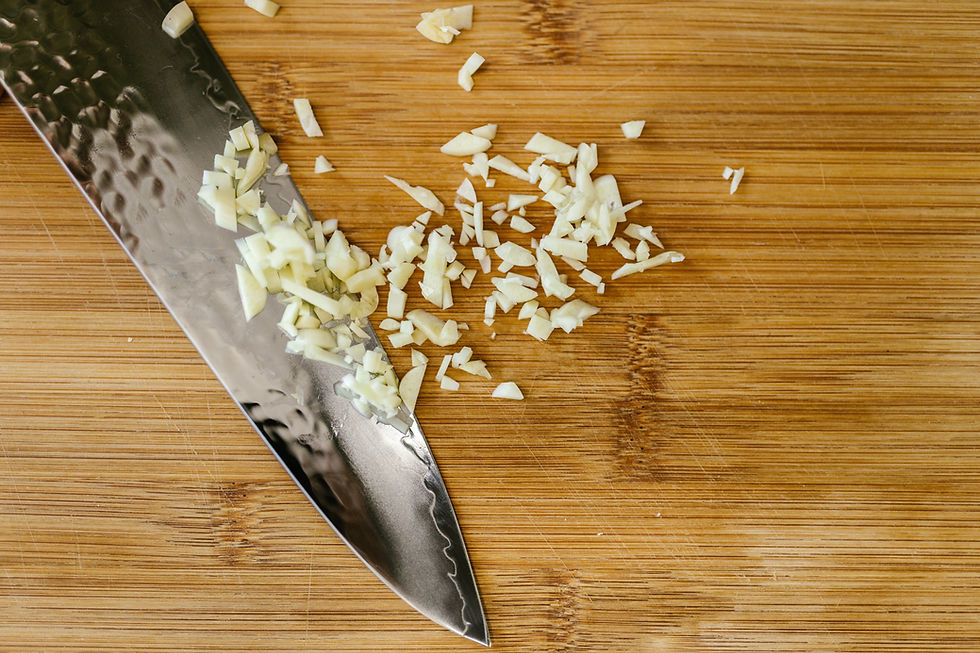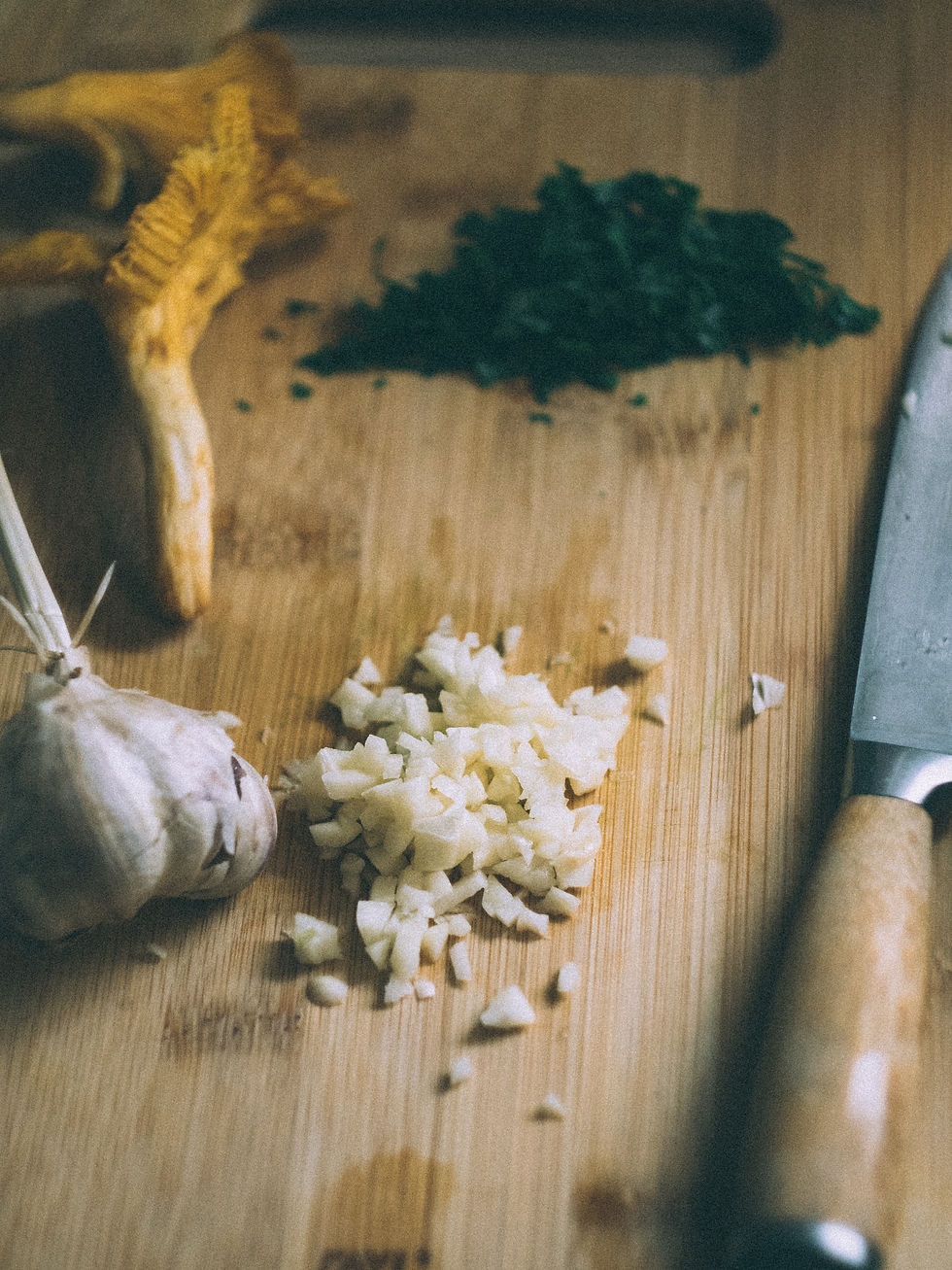Garlic is a key ingredient in the cuisines of many cultures. Growing up on St. Croix, my mother would make every savory dish with several cloves of garlic, either adding them directly to the pot or including them as part of a sofrito. To listen to this article, click here.

Every great plate of food starts here, trust me.
I often get asked about the health benefits of garlic – most commonly in the context of battling a cold or lowering high blood pressure. It turns out that garlic does have some properties that may make it useful for combating those conditions and much more. Keep reading to find out:
The biochemical properties of garlic that make it so great for our health
What research has been done on health outcomes related to eating garlic
How to prepare it in order to maximize its potency
Topic 1: The properties of garlic
Garlic is a member of the genus Allium. Its characteristic pungent smell is due to its high concentration of organosulfur compounds, specifically, allyl sulfides. These same compounds cause garlic breath, but beyond that, they have several health benefits.
The chief allyl sulfide in garlic is S-allyl L-cysteine sulfoxide, also known as alliin. Alliin is just one version of the molecule that gives garlic its healing properties, however. For it to be turned into its active form, it needs to mix with the enzyme alliinase. Enzymes are proteins that make pretty much all of the chemical reactions in our bodies possible. The enzyme alliinase is already present in garlic, but in order for it to do its job, the garlic much be crushed, chopped, or chewed. Once that happens, alliinase the enzyme can access the alliin and turn it into allicin. Allicin is the the version that gets absorbed into our intestines.

Alliinase basically takes the molecule alliin, which is normally in the off position, and switches it to the on position where it gets a different name - allicin.
Once absorbed and broken down further, allicin can help to:
Reduce inflammation,
Eliminate microbes,
And protect our bodies from oxidative damage, a type of damage which is associated with pretty much any chronic disease that you can think of.

Hippocrates was right about food being medicine, especially when it comes to plants like garlic.
As an antioxidant, allicin scavenges free radicals and increases the activity of glutathione, another very important antioxidant. Allicin also helps certain enzymes in our bodies to work well. One of these enzymes is endothelial nitric oxide synthase, or eNOS. When eNOS is in tip top shape, it is able to tell our cells to make more nitric oxide. Nitric oxide is crucial for keeping our blood vessels from stiffening, and this in turn reduces our risk of having cardiovascular problems.
Allicin also has one more cool function. It has the ability to switch on the genes that signal our bodies to make more antioxidants and detox enzymes. It does this by activating the transcription factor nuclear factor erythroid 2-related factor 2. Thankfully, this molecule also has a nickname: Nrf2. Nrf2 binds to a specific part of our genes called the antioxidant response element (ARE), a process that tells our DNA to make more antioxidants and detoxification enzymes. With more of these substances present, our bodies become more efficient at getting rid of toxins.

This is how you detox.
So far, we have covered how allicin in garlic gets activated, and its ability to reduce inflammation, keep our cardiovascular system healthy, and help our body to detox itself. Now, let’s look at some of the health outcomes that have been studied in relation to garlic.
Topic 2: Health outcomes related to garlic
Data collected from thousands of adults suggests that garlic can help to lower total cholesterol and low-density lipoprotein (LDL) cholesterol after 2 months of consuming it regularly. There is also evidence that garlic supplements in combination with normal diabetes treatment can help to lower fasting blood sugar and hemoglobin A1c, which you may see on your blood test as HbA1c%. In research involving people with diabetes, taking garlic tablets has also been demonstrated to lower triglycerides, total cholesterol, and LDL cholesterol. Additionally, consuming garlic has been shown to reduce pain and inflammation associated with osteoarthritis.

Most of these studies used pretty high concentrations of garlic in the form of supplements, so it would take more than a couple of dashes of garlic power in your hummus to get these benefits.
Now, I also want to take a moment to highlight the research that has been done on garlic which has helped us to understand what garlic may not be beneficial for.
Helicobacter pylori (H. pylori) infections are a common cause of peptic ulcers. An infection with this bacterium can increase the risk of stomach cancer. A number of studies have been done to examine the effect of garlic on this sometimes-silent microbe. Unfortunately, garlic does not seem to help with preventing H pylori infections or getting rid of them.
Colorectal cancer is another outcome that has been evaluated in the context of garlic consumption. For this outcome, the findings are mixed – some studies (like this one and this one) suggest that eating lots of garlic can lower cancer risk, while others have found nothing. More clinical trials are needed before we can be sure of the relationship between garlic and colorectal cancer.
What about if you have a cold – does garlic help with that? This is a case where it seems like garlic may be deserving of the clout that it gets, but we just do not have enough data to be sure. Only one clinical trial has shown that taking garlic supplements for 3 months led to fewer occurrences of the common cold.

The evidence for eating garlic as a way to stave off colds is sadly limited.
To summarize, garlic – mainly as a supplement – has been shown to help with lowering total cholesterol, LDL cholesterol, triglycerides, and blood sugar. Garlic does not appear to have any effect on H pylori, and its role in colorectal cancer prevention is unclear. There is one study that suggests that garlic may reduce a person’s likelihood of catching a cold, but more clinical trials are needed. Now that you know the benefits of eating garlic, let’s talk about how to prepare it.
Topic 3: How to maximize the benefits of garlic
Food preparation is key for getting the most bang for your buck when it comes to optimizing your diet for health. Let’s take a moment to talk about how to prepare garlic in order to get the maximum benefits from it.
The thing you want to remember to do is to chop garlic and let it sit for 10 minutes before cooking. Now, this may sound like a bit of a nuisance, especially for those times when you are trying to get a quick meal prepared, but there is a good rationale behind this recommendation. Waiting to cook your garlic lets the alliinase enzyme do its job of converting alliin to allicin. Remember, alliin is the inactive form, and allicin is the active form.

If you have time to do this, you have time to let your garlic sit. You can do it.
Now, you may be wondering, “if the enzyme is already in the garlic, why does it matter if the garlic is chopped or not?” Well, the chopping is essential for putting the alliinase in contact with the alliin. The waiting period is important because alliinase is a sensitive molecule – it is destroyed by acid and heat. So, if you throw your garlic into the pan right after chopping it, the enzyme will be destroyed, and you won't get any allicin. Similarly, if you were so inclined to eat your garlic whole or right after cutting it, your stomach acid would obliterate the enzyme, again leaving you with no allicin. Remember, we like allicin because this is the active form of the molecule.

This may look like a simple pile of dead plant material, but there are actual many chemical reactions taking place here.
Quick disclaimer: Talk to your primary care team if you have heart burn, stomach upset, allergies, or a condition that requires you to take anticoagulant drugs such as warfarin before you decide to up your garlic intake.
If you learned anything new or think that someone you care about could benefit from this information, share this article, and subscribe to the blog for regular updates on commonly asked nutrition questions.
Enjoy today!
References:
Ansary, J., Forbes-Hernández, T. Y., Gil, E., Cianciosi, D., Zhang, J., Elexpuru-Zabaleta, M., Simal-Gandara, J., Giampieri, F., & Battino, M. (2020). Potential Health Benefit of Garlic Based on Human Intervention Studies: A Brief Overview. Antioxidants (Basel, Switzerland), 9(7), 619. https://doi.org/10.3390/antiox9070619
Bhattacharyya, M., Girish, G. V., Karmohapatra, S. K., Samad, S. A., Sinha, A. K. (2007). Systemic production of IFN-alpha by garlic (Allium sativum) in humans. Journal of Interferon & Cytokine Research, 27(5):377-82. doi: 10.1089/jir.2006.0124. PMID: 17523869.
Chiavarini, M., Minelli, L., Fabiani, R. (2016). Garlic consumption and colorectal cancer risk in man: a systematic review and meta-analysis. Public Health Nutrition, 19(2):308-317.
FitzGerald, R., Smith, S. M. (2021). An Overview of Helicobacter pylori Infection. Methods in Molecular Biology, 2283:1-14. doi: 10.1007/978-1-0716-1302-3_1. PMID: 33765303.
Fleischauer, A. T., Poole, C., Arab, L. (2000). Garlic consumption and cancer prevention: meta-analyses of colorectal and stomach cancers. American Journal of Clinical Nutrition, 72(4):1047-1052
Galeone, C., Pelucchi, C., Levi, F. (2006). Onion and garlic use and human cancer. American Journal of Clinical Nutrition, 84(5):1027-1032.
Garlic. (2014, April 28). Garlic. Linus Pauling Institute. https://lpi.oregonstate.edu/mic/food-beverages/garlic
Higashi, Y., Noma, K., Yoshizumi, M., Kihara, Y. (2009). Endothelial function and oxidative stress in cardiovascular diseases. Circulation Journal, 73(3):411-8. doi: 10.1253/circj.cj-08-1102.
Horev-Azaria, L., Eliav, S., Izigov, N. (2009). Allicin up-regulates cellular glutathione level in vascular endothelial cells. European Journal Of Nutrition, 48(2):67-74.
Lissiman, E., Bhasale, A. L., Cohen, M. (2014). Garlic for the common cold. Cochrane Database of Systematic Reviews, 2014(11):CD006206. doi: 10.1002/14651858.CD006206.pub4.
Phil, R. A., Khan, R. A., Ashraf, I. (2011). Effects of garlic on blood glucose levels and HbA1c in patients with type 2 diabetes mellitus. Journal of Medicinal Plants Research, 5, 2922–2928.
Ried, K., Toben, C., Fakler, P. (2013). Effect of garlic on serum lipids: an updated meta-analysis. Nutrition Reviews, 71(5):282-99. doi: 10.1111/nure.12012.
Sjomina, O., Pavlova, J., Niv, Y., Leja, M. (2018). Epidemiology of Helicobacter pylori infection. Helicobacter, 23 Suppl 1:e12514. doi: 10.1111/hel.12514.

コメント